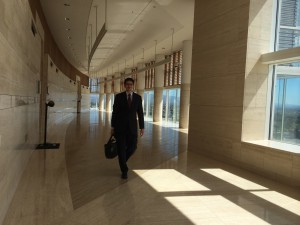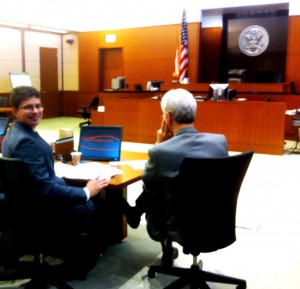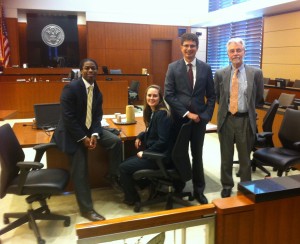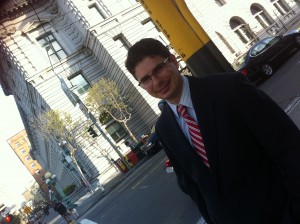RJ GAUDET & ASSOCIATES L.L.C.
"Let us realize the arc of the moral universe is long but it bends toward justice."
Dr. Martin Luther King, Jr.
Posts Tagged ‘class actions’
California Supreme Court Might Require Class Counsel Seeking Fees as a Percentage of Common Fund to Support Their Requests With a Lodestar Cross-Check
By Robert J. Gaudet, Jr.[i]

Karin Gaudet-Asmus and Robert J. Gaudet, Jr. standing before the door to the courtroom in the California Supreme Court immediately after the oral argument on Friday, May 27, 2016.
In oral argument on Friday, May 27 in Laffitte v. Robert Half Int’l, No. S222996 (Cal.), the California Supreme Court gave some indications that it might require class counsel in California to support motions seeking attorney’s fees a percentage of a common fund with a lodestar cross-check. The court showed interest in the possibility of putting boundaries around the discretion of trial courts, on awarding fees, including but not limited to requiring class counsel to submit time sheets, appointing a guardian for the class, or limiting the amount of the lodestar multiplier. A “lodestar cross-check” would require class counsel to present hours expended, hourly rates, and a “multiplier” (e.g. 2 or 4 or another number) to demonstrate that the amount of fees sought as a percentage is similar to the cross-check amount. The underlying decision on appeal, Lafitte v. Robert Half Int’l, Inc., No. B249253, 2014 Cal.App. Lexis 1059 (Cal. 2d App. Dist, Div. 7, Oct. 29, 2014) was a wage and hour class action that settled for $19 million.
Introduction
On Friday, May 27, 2016, a full panel of seven justices heard Berkeley lawyer Lawrence Schonbrun’s oral argument challenging the way California class action lawyers are paid. On behalf of class member Brennan, Mr. Schonbrun argued that calculating attorney’s fees as a percentage of a common fund is unlawful and that fees should be calculated on the basis of hours worked rather than as a percentage of a settlement. The Supreme Court’s decision on this argument, which will be released within 90 days after last Friday’s hearing, is likely to have significant implications for class action practice in California.
Mr. Schonbrun argued that a 1977 California Supreme Court decision called Serrano III[ii] requires California state courts to award attorney’s fees based upon the number of hours worked. He asked the Supreme Court to prohibit trial courts from awarding fees based on a percentage of a class settlement fund or “common fund.” He argued the current trend by which courts award class action lawyers a percentage of settlements is contrary to Serrano III which sought to protect the prestige of the judiciary and the integrity of the bar by using hours expended as the “starting point of every fee award.”
Does Serrano III Apply to Common Fund Cases?
At the start of the hearing, Chief Justice Cantil-Sakauye pointed out that Mr. Schonbrun’s argument rested on footnote 23 of the Serrano III decision which held that the “starting point of every fee award … must be a calculation of attorney’s services in terms of he time he has expended on the case.” She said, “it seems odd we’d put the language in a footnote” if it was so central to our decision. She suggested that Serrano III might be distinguished because it was not a “common fund” case in the “first place.” Mr. Schonbrun replied she was “focusing on the wrong point” and that Serrano III addressed the equitable power of a court to allocate fees in common funds.
Mr. Schonbrun noted that, although Serrano III was not a common fund case, each one of the two federal cases that Serrano III relied upon, in saying that hours expended are the starting point for a fee determination, was a common fund case. Mr. Schonbrun argued it was “incredulous that the Supreme Court would’ve referred to common fund cases [in Serrano III] and not meant the decision to apply to a common fund.” A common fund is created when class action lawyers negotiate a settlement that pays a certain amount of money (or a “common fund”) to class members. Class counsel often ask for a percentage of this common fund as their attorney’s fees.
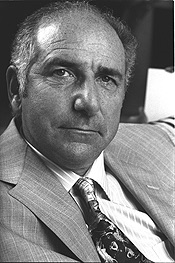
Lawrence Schonbrun, the Berkeley lawyer who represented Appellant class member Brennan in argument before the California Supreme Court.
On behalf of appellees, class counsel Kevin Barnes argued the language in Serrano was dicta and the Supreme Court would not have to reverse Serrano to affirm the lower court’s award of fees as a percentage of the settlement.
Since the Chief Justice was not the only justice posing questions that involved distinguishing Serrano III from common fund cases, it seems possible the Supreme Court will rule that Serrano III does not apply. Justice Werdegar, for instance, asked a question that rested on the premise that the court would distinguish Serrano as a case that did not involve a common fund. Given these lines of questioning, the justices might hold that footnote 23 is dicta, as the appellees urged, and hold that the wording in footnote 23 does not apply to a common fund.
Given the wide scope of questioning and the long duration of oral argument, even if the justices distinguish Serrano, it seems likely they will offer some guidance or parameters on the issue of attorney’s fees in class actions.
The justices seemed to have some concerns over a problem articulated by Mr. Schonbrun: after a class settlement has been reached and class counsel seek a fee, which is taken out of the class’s settlement fund, they “abandon” the class at that stage of the proceedings, Mr. Schonbrun argued. Justice Mariano-Florentino Cuéllar asked Mr. Schonbrun to “unpack that – is the class abandoned?” Mr. Schonbrun argued, “they are trying to reduce the class’s recovery,” the class does not have its own experts to argue against fee applications, and “they’ve been abandoned.”
Policy Recommendations
The justices seemed to be searching for fixes. Responding to Justice Corrigan’s question about what “you’re asking for,” Mr. Schonbrun advocated various measures:
- Require class counsel to produce time sheets for review;
- Prohibit awarding fees as a percentage of money paid by the defendant as part of a settlement;
- Appoint a guardian for the class, paid by the class, in cases where class settlements are $1 million or more so the guardian can scrutinize any application for attorney’s fees;
- Appoint experts to help the class scrutinize billing records of class counsel in those cases where class counsel use experts to justify their fee applications;
- Award fees to class counsel at rates charged by “capable, competent” lawyers rather than at the rates charged by “celebrity” lawyers.
Mr. Schonbrun delivered a passionate argument, informed by decades of experience as objector’s counsel, although it was his first time in the California Supreme Court. In oral argument, he summarized the opposition as: “they want more money. They want more money. That’s what this case is about, and you shouldn’t give it to them.” Mr. Schonbrun argued the percentage method results in a windfall for counsel at the expense of the class. Mr. Schonbrun noted that, if fees were awarded as a percentage, then it would be “inappropriate” to use the same percentage – e.g. 33.33% – that is taken from “single client-lawyer” contingency fee agreements. The lower court had awarded Mr. Barnes 1/3 of the settlement fund as attorney’s fees.
Percentage Method With Lodestar Cross-Check
At times during the hearing, the justices seemed sympathetic to Mr. Schonbrun’s argument that the percentage method is flawed. Judge Liu remarked, “there is a House of Cards feel to all of this.” His comparison to the House of Cards – which portrays drug use, murder, and infidelity by politicians – was not a flattering portrayal of the status quo. However, despite these concerns, the general thrust of questioning indicated the justices might preserve the percentage method but subject it to a lodestar cross-check.
The justices posed multiple questions about the cross-check. For instance, Justice Chin asked Mr. Barnes, appellees’ counsel, “is there any reason not to cross check each time?” Mr. Barnes did not really answer the question but said there was no need for a cross-check in a case he worked on for seven years and for which he was awarded 1/3. Therefore, Justice Mariano-Florentino Cuéllar asked again, “why not have a cross check in every case?” Mr. Barnes said it would be a “burden” on the judge and the parties.
A lodestar cross-check is a method by which courts look at the hours expended, multiply those hours by the hourly rates, and then increase the overall figure by a “lodestar multiplier” such as 2 or 4 or 10.
Justice Werdegar noted the trial judge had awarded fees as a percentage of the settlement fund and, then, tested it with a lodestar cross-check. Mr. Schonbrun responded they can “attempt to falsely justify a percentage fee” by using a cross-check that supports the same figure. Justice Chin asked if the “multiplier” that is often used to increase the lodestar is “based on the risks in the case.” Mr. Schonbrun argued a lodestar cross-check can be misused for “reverse engineering” to support an inflated fee that is first calculated under the percentage method. Picking up on this language, both Justice Chin and Justice Liu used the term “reverse engineering” in their questioning.
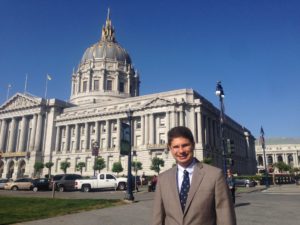
Robert J. Gaudet, Jr. standing in front of the San Francisco City Hall adjacent to the building that houses the California Supreme Court, Friday, May 27, 2016.
The Prevalence of the Percentage Method
Justice Werdegar picked up on empirical data, presented in Prof. Rubenstein’s amicus curiae brief, that the “prevalent system” used by courts is to award fees as a percentage. She pointed this out to Mr. Schonbrun, saying federal and state courts have “adopted” the percentage method. Mr. Schonbrun referred her to a 2015 Columbia Law Review article[iii] that found the percentage method was not working. The article, as quoted in Mr. Schonbrun’s briefing, stated:
Even more troubling are our findings regarding the role of the courts in the fee-setting process. We found no evidence that the actions taken by the courts move class counsel’s fees closer to the “right price … In sum, there is little to celebrate in the current state of affairs, and reason to think that even small improvements in the fee-setting process might yield significantly better results.
Using this source, Mr. Schonbrun argued the percentage method is flawed and the Supreme Court should reinforce the message of Serrano III that the lodestar is the starting point for every fee award. Indicating her disagreement with Mr. Schonbrun, Justice Werdegar said, “tell us the flaws of the percentage method with the lodestar cross-check.” This question indicated, as did others, that the justices might prefer to keep the percentage method but require a lodestar cross-check. There was very little questioning about what might happen if the percentage method were rejected.
Court-Appointed Guardian For the Class
Mr. Schonbrun argued the Supreme Court should require trial courts to appoint a guardian to look after the interests of the class when class counsel ask for attorney’s fees to be awarded out of a settlement fund. When Justice Werdegar asked, “what should we do,” Mr. Schonbrun responded they should appoint a guardian in all cases over $1 million. Justice Werdegar said it was “too late” for this case but Mr. Schonbrun indicated they “can send it back” to the trial court. Chief Justice Cantil-Sakauye asked, “has any other court required a guardian?” Mr. Schonbrun said no but argued the first question was to determine if he was right, “is the class abandoned?” Although Mr. Schonbrun did not mention it in his argument, courts have appointed Special Masters, magistrates, and experts to assist with the administration of class actions.
Justice Werdegar asked, “was there a motion for a guardian,” indicating the justices might dispose of this suggestion on procedural grounds for not being properly raised in the lower courts. Mr . Schonbrun replied, “no” but said the Supreme Court had a fiduciary obligation to make sure the class is the predominant party. He suggested the court had standing to consider the issue under a fiduciary duty to protect class members.
Five Amicus Curiae
The amount of legal power that was deployed against Mr. Schonbrun was staggering. In addition to an opposition brief filed by class counsel Kevin Barnes, there were five opposition briefs filed by amici curiae, i.e., friends of the court. One of them was filed on behalf of eight class action law professors by San Francisco-based class action firm Lieff Cabraser. Mr. Schonbrun pointed out in his reply brief that some of these professors had served as paid experts on behalf of class counsel in other cases and, even, served as class counsel themselves, so they had obvious biases. In the tobacco litigation, some of the same experts had supported fees as high as $21,000 per hour, as Mr. Schonbrun pointed out in a response to an amicus brief, because counsel (including Lieff Cabraser) were not satisfied with an award of $7,700 per hour as described by the Atlantic Monthly in an article titled “Greed on Trial.” Other amici briefs were filed by the Impact Fund, Western Center on Law and Poverty and 14 unspecified California legal service organizations; Prof. William Rubenstein; Consumer Attorneys of California; and Working Wardrobes.
Arguments By Appellees
At the hearing, Kevin Barnes argued on behalf of appellees and Michael Rubin argued on behalf of amicus curiae Impact Fund. The issue of the trial court’s discretion was a common theme in their arguments. One of them argued the trial court’s discretion should be respected because the judge “lives with the case.” In his rebuttal argument, Mr. Schonbrun pointed out that the judge did not live with the case and that, in this instance, there had been four or five different trial judges. Justice Mariano-Florentino Cuéllar asked, “the judge in general does not have the responsibility [to review time sheets] with the cross check? What must a judge do?” Mr. Barnes said the judges have “discretion” to use the cross-check “if they want to.” Justice Werdegar asked if it “always starts with 1/3?” and Mr. Barnes said it was up to the judge’s “discretion.”
Asked how they should write the opinion if they agreed with Mr. Barnes, Mr. Barnes said the justices should tell trial courts they have “discretion, it is up to you.” Justice Mariano-Florentino Cuéllar noted, “discretion is a powerful word.” His comment and the generality of Mr. Barnes’s responses seemed to question whether the Supreme Court wants to leave full and unfettered discretion up to trial courts. Testing the boundaries, Justice Mariano-Florentino Cuéllar asked Mr. Barnes “what do we say about the limits of a trial court’s discretion?” Mr. Barnes did not give any examples.
Apparently provoked by Mr. Barnes’s failure to note any limits, Justice Liu said it raises a “policy question” and asked “what is this based on” and “what justifies a multiplier except reverse engineering back from the multiplier?” Mr. Barnes answered there is a “fair market value to these services.” Justice Liu asked, “by fair market value, do you mean what is adequate incentive to get a lawyer to take it?” Mr. Barnes replied, yes, and said the potential for default is more than the average case. Trying to help Mr. Barnes answer Justice Liu’s question, Justice Chin said, “so, it’s a cross-check, not reverse engineering?” Mr. Barnes replied “yes.” Justice Chin’s leading question, again, demonstrated the court might be leaning towards requiring a lodestar cross-check in its pending decision.
Justice Kruger asked Mr. Barnes, “if the [trial] court does not exercise a cross-check, how does the court know [the fee awarded as a percentage of the settlement] is not more than necessary?” Mr. Barnes answered, “based on the trial court’s experience.” Justice Werdegar asked how class counsel’s fiduciary duty works at the stage where they request fees, and Mr. Barnes replied, “the marketplace.” Justice Werdegar, perhaps trying to help Mr. Barnes elaborate upon his incomplete answer, asked “counsel’s integrity?” Mr. Barnes took the bait and said, “we have a client,” which suggests that he might have presented his fee petition to the class representative for review.
Justice Liu remarked, “all markets exist in a regulatory framework. If we want to toss out the percentage [method], are you saying there are cases nobody would take? Is there any empirical evidence for that?” Mr. Barnes did not directly answer but referred to the 1/3 contingence fee model. Testing whether there are any limits to “discretion,” Justice Mariano-Florentino Cuéllar asked for an example of a “1/3 recovery that would not meet the [trial] court’s discretion?” Mr. Barnes said that if there was a $1 million recovery in a case worth $10 million where there were no depositions and the case was little litigated, then the judge should rule that a 1/3 fee is not reasonable because counsel “did no work on the case.”
When both Justice Mariano-Florentino Cuéllar and Justice Werdegar asked whether a trial court should review hours expended in time sheets, Mr. Barnes said the trial court had “discretion” and did not have to review time sheets.
In his oral argument, Mr. Rubin conceded, “we don’t [know]” when Justice Liu asked, when a court uses a “lodestar as cross-check, how do we know what is a reasonable multiplier: 2, 4, 5, 8, 10?” Mr. Rubin also said, “we do the best that our trial judges do based on their own experience.” Justice Liu asked, “is any multiplier too high?” Mr. Rubin responded, “no.” Justice Liu’s question indicated the Supreme Court has some interest in knowing whether there are any boundaries to a trial court’s discretion. Following on this theme, Justice Mariano-Florentino Cuéllar asked, “what if he multiplier is 1,000?” Mr. Rubin said “I’ve never seen that. I’ve seen over 20.”
Mr. Rubin’s candid responses were not likely to comfort the justices that there are reasonable bounds on discretion. Justice Chin asked if “we should leave it to the discretion of the trial judge” and Mr. Rubin said, “yes.” Chief Justice Cantil-Sakauye seemed eager to bolster Mr. Rubin’s argument and asked him a leading question, noting these “cases go to highly specialized courts with staff selected for their experience with civil matters – that’s all they do. They do not got to general assignment, correct?” Mr. Rubin said, “yes.” The Chief Justice’s question indicates she might prefer to leave the choice of methodology up to the trial court.
Justice Liu compared the percentage method to executive compensation which is “laughable” and said the percentage method was “circular.” Mr. Rubin admitted, “there is some [circularity].” Mr. Rubin said there is “extraordinary risk” and “most people expect a percentage of recovery will go to lawyers. They see it on TV. This market has developed.” Mr. Rubin’s comment suggested single lawyer-single client cases, as advertised on TV, have conditioned class members to expect a percentage of any class settlement will go to class counsel. Mr. Rubin noted a “split between state and federal courts” and said, “state courts don’t require a load of detail or time records as [do] the federal courts.”
In rebuttal, Mr. Schonbrun pointed out, “they keep saying ‘market.’ There’s no market, there’s no competition.” Justice Liu stated, “we have to check these percentage fees against something – that has to be lodestar –what if we put some boundaries around that. What if we do that?” The Chief Justice then asked Mr. Schonbrun to clarify, “you want to prohibit the percentage under Serrano?” and Mr. Schonbrun said “yes, Serrano was right” and placing trust in “experienced [trial] judge is not enough.”
Conclusion
Justice Liu’s comments are instructive and possibly telling about the Supreme Court’s search for boundaries on a trial court’s discretion. Although Justice Liu had some of the strongest words of criticism, comparing a trial court’s discretion with the “House of Cards,” he also indicated “we have to check these percentage fees … [with the] lodestar [cross-check].” In other words, although it may seem like the House of Cards, Justice Liu does not seem inclined to overturn it by prohibiting the percentage method.
The questions posed by Justice Mariano-Florentino Cuéllar (asking if a multiplier of 1,000 would be too high), Justice Kruger (asking how do we know if fees are too high if we do not use a cross-check), Justice Werdegar (asking how class counsel’s fiduciary duties operate at the fee-setting stage), and Justice Liu (noting the percentage method is “circular” and it seems like the House of Cards) indicate a majority of the seven-member court has concerns over the boundaries on discretion. Mr. Barnes and Mr. Rubin did not suggest any boundaries but simply referred to a trial judge’s “experience” and seemingly unlimited “discretion.”
Given the line of questioning at the hearing, it seems possible the Supreme Court will impose new parameters, e.g. the use of a lodestar cross-check or a court-appointed guardian, on future fee applications in California state courts.
[i] Robert J. Gaudet, Jr. has served as class counsel in employment, consumer, breach of contract, discrimination, and other class actions and previously objected to class settlements and fee applications. He is licensed in Texas and Washington and cooperates with lawyers in other jurisdictions. Mr. Gaudet is the principal of RJ Gaudet & Associates LLC.
[ii] Serrano v. Priest (Serrano III), 20 Cal.3d 25, 141 Cal.Rptr. 315 (Cal. Oct. 4, 1977).
[iii] Lynn A. Baker, Michael A. Perino, and Charles Silver, Is the Price Right? An Empirical Study of Fee Setting in Securities Class Actions, 115 Colum. L. Rev. 1371 (Oct. 2015).
